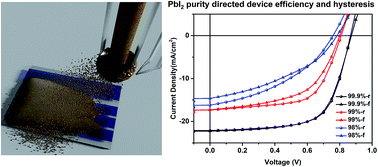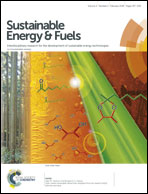The impacts of PbI2 purity on the morphology and device performance of one-step spray-coated planar heterojunction perovskite solar cells†
Abstract
We have fabricated planar heterojunction perovskite solar cells by one-step ultrasonic spray-coating of the perovskite precursor solution in air. Uniform perovskite films with high surface coverage can be prepared after optimization of the precursor solution and spray-coating parameters. We found that the purity of PbI2, although varying only from 98 to 99.9%, can significantly affect the crystallinity, grain size and boundaries of MAPbI3 films that were fabricated via one-step spray-coating, and ultimately determined the power conversion efficiency (PCE) of perovskite devices. PbI2 with a purity of 98% resulted in a low conversion of precursors to perovskites, whilst a high purity of 99.9% led to perovskites with a high crystallinity, large grain size and narrow grain boundaries. Our p–i–n type, planar heterojunction solar cell ITO/PEDOT:PSS/MAPbI3/PCBM/Ag made from MAI and 99.9% purity PbI2 achieved a maximum PCE of 12.6% without hysteresis, whereas the 98% purity PbI2-based device showed a low PCE of only 4.9% with the presence of hysteresis. However, the impacts of PbI2 purity on the device efficiency can be minimized by changing the deposition method from one-step spray-coating to a two-step spin casting approach.



 Please wait while we load your content...
Please wait while we load your content...